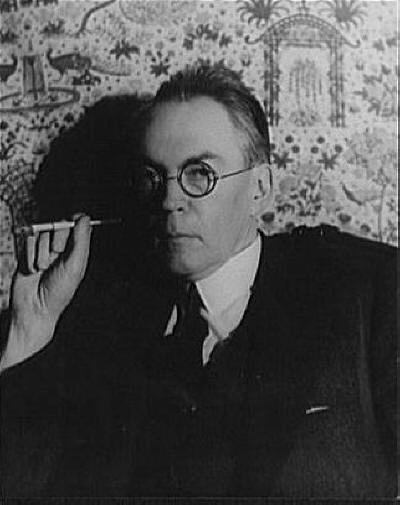

Queer Places:
College of William & Mary, 101 Ukrop Way, Williamsburg, VA 23186
Branch House, 101 E Franklin St, Richmond, VA 23219
3201 Monument Ave, Richmond, VA 23221
Hollywwod Cemetery, 412 S Cherry St, Richmond, VA 23220
 James
Branch Cabell (April 14, 1879 – May 5, 1958) was an American author of
fantasy fiction and
belles-lettres. Cabell was well-regarded by his contemporaries,
including
H.
L. Mencken,
Edmund Wilson, and
Sinclair Lewis. His works were considered escapist and fit well in the
culture of the 1920s, when they were most popular. For Cabell, veracity was
"the one unpardonable sin, not merely against art, but against human welfare."[1][2]
James
Branch Cabell (April 14, 1879 – May 5, 1958) was an American author of
fantasy fiction and
belles-lettres. Cabell was well-regarded by his contemporaries,
including
H.
L. Mencken,
Edmund Wilson, and
Sinclair Lewis. His works were considered escapist and fit well in the
culture of the 1920s, when they were most popular. For Cabell, veracity was
"the one unpardonable sin, not merely against art, but against human welfare."[1][2]
Although escapist, Cabell's works are ironic and satirical. H. L. Mencken disputed Cabell's claim to romanticism and characterized him as "really the most acidulous of all the anti-romantics. His gaudy heroes ... chase dragons precisely as stockbrockers play golf." Cabell saw art as an escape from life, but once the artist creates his ideal world, he finds that it is made up of the same elements that make the real one.[1]
Interest in Cabell declined in the 1930s, a decline that has been attributed in part to his failure to move out of his fantasy niche despite the onset of World War II. Alfred Kazin said that "Cabell and Hitler did not inhabit the same universe".[1]
Cabell was born into an affluent and well-connected Virginian family, and lived most of his life in Richmond. The first Cabell settled in Virginia in 1664; Cabell's paternal great-grandfather, William H. Cabell, was Governor of the Commonwealth from 1805 to 1808. Cabell County in West Virginia is named after the Governor. James Branch Cabell's grandfather, Robert Gamble Cabell, was a physician; his father, Robert Gamble Cabell II (1847–1922), had an MD, but practiced as a druggist; his mother, Anne Harris (1859–1915), was the daughter of Lieutenant Colonel James R. Branch, of the Army of the Confederate States of America. James was the oldest of three boys—his brothers were Robert Gamble Cabell III (1881–1968) and John Lottier Cabell (1883–1946). His parents separated and were later divorced in 1907.[3] His aunt was the suffragist and educationist Mary-Cooke Branch Munford.[4]
Although Cabell's surname is often mispronounced "Ka-BELL", he himself pronounced it "CAB-ble." To remind an editor of the correct pronunciation, Cabell composed this rhyme: "Tell the rabble my name is Cabell."
Cabell matriculated at the College of William and Mary in 1894 at the age of fifteen and graduated in June 1898. While an undergraduate, Cabell taught French and Greek at the College. According to his close friend and fellow author Ellen Glasgow, Cabell developed a friendship with a professor at the college which was considered by some to be "too intimate" and, as a result Cabell was dismissed, although he was subsequently readmitted and finished his degree.[5] Following his graduation, he worked from 1898 to 1900 as a newspaper reporter in New York City, but returned to Richmond in 1901, where he worked several months on the staff of the Richmond News.[3]
1901 was an eventful year for Cabell: his first stories were accepted for publication, and he was suspected of the murder of John Scott, a wealthy Richmonder. It was rumored that Scott was involved romantically with Cabell's mother. Cabell's supposed involvement in the Scott murder and his college "scandal" were both mentioned in Ellen Glasgow's posthumously published (1954) autobiography The Woman Within.[5] In 1902, seven of Cabell's first stories appeared in national magazines and over the next decade he wrote many short stories and articles, contributing to nationally published magazines including Harper's Monthly Magazine and The Saturday Evening Post, as well as carrying out extensive research on his family's genealogy.[3]
Between 1911 and 1913, he was employed by his uncle in the office of the Branch coal mines in West Virginia. On November 8, 1913, he married Priscilla Bradley Shepherd, a widow with five children from her previous marriage.[3] In 1915, son Ballard Hartwell Cabell was born. Priscilla died in March 1949; Cabell was remarried in June 1950 to Margaret Waller Freeman.
During his life, Cabell published fifty-two books, including novels, genealogies, collections of short stories, poetry, and miscellanea. He was elected to the American Academy of Arts and Sciences in 1937.
Cabell died of a cerebral hemorrhage in 1958 in Richmond, and was buried in the graveyard of the Emmanuel Church at Brook Hill. The following year the remains of Cabell and his first wife were reinterred in Hollywood Cemetery.[6]
Significant Cabell collections are housed at various repositories, including Virginia Commonwealth University and the University of Virginia.
Cabell maintained a close and lifelong friendship with well-known Richmond writer Ellen Glasgow, whose house on West Main Street was only a few blocks from Cabell's family home on East Franklin Street. They corresponded extensively between 1923 and Glasgow's death in 1945 and over 200 of their letters survive. Cabell dedicated his 1927 novel Something About Eve to her, and she in turn dedicated her book They Stooped to Folly: A Comedy of Morals (1929) to Cabell. In her autobiography, Glasgow also gave considerable thanks to Cabell for his help in the editing of her Pulitzer Prize-winning book In This Our Life (1941). However, late in their lives, friction developed between the two writers as a result of Cabell's critical 1943 review of Glasgow's novel A Certain Measure.[5]
Other book-length studies on Cabell were written during the period of his fame by Hugh Walpole,[18] W. A. McNeill,[19] and Carl van Doren.[20] Edmund Wilson tried to rehabilitate his reputation with a long essay in The New Yorker.[21]
My published books:
https://en.wikipedia.org/wiki/James_Branch_Cabell